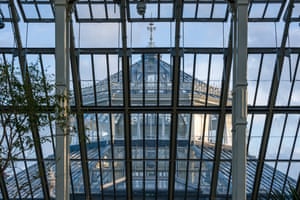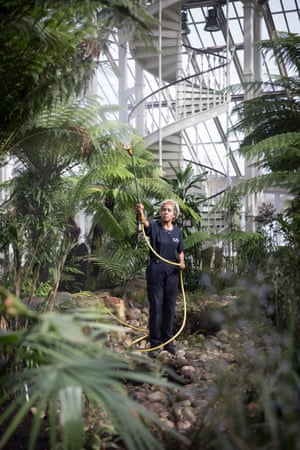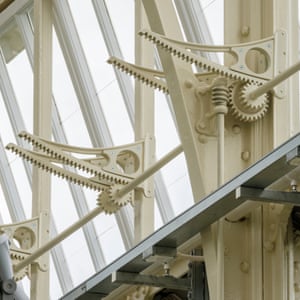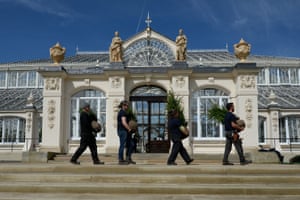Feral goats are the greatest threat to the rare cabbage tree, according to a sign in Kew Gardens’ newly restored Temperate House, the largest Victorian glasshouse in the world, which reopens this week after a £41m, five-year renovation. Goats were never much of a threat at Kew, where the endangered species has been carefully cultivated since a specimen was found on the tiny, volcanic Robinson Crusoe Island near Chile. But rusting iron columns and creaky windows had posed a significant danger, to plants and humans alike.
A government report into the state of the national botanic gardens in 2010 concluded of the building that “urgent restoration is essential if closure is to be avoided”. Windows had been sealed shut in a 1970s refurb and masonry cladding was crumbling off in chunks. The last five years have seen 69,000 individual elements removed and repaired and 15,000 panes of glass replaced, all under the safe cover of a temporary tent big enough to hold three Boeing 747s. It has been a mammoth undertaking, and the result is suitably breathtaking.
Those who remember entering the thick green gauntlet, surrounded on all sides by dense forest, might be shocked by the pruning. For the first time since the glasshouse opened in 1862, the entire contents of the beds have been removed, soil and all, and the layout reconfigured to be more akin to the Victorian original. Ten thousand plants have been replaced with younger specimens, mostly cultivated from cuttings of their forebears, while some famous residents have been carefully returned after spending the last few years in a temporary nursery. Kew’s rarest (and loneliest) plant of all, a male Wood’s cycad, is back in position, still awaiting the discovery of a female of the species in some untrodden corner of the planet. Compared with the previous overgrown riot, where spiky leaves of cycads rubbed up against the trunks of bitter orange trees, and tree ferns competed for space with rhododendrons, it now feels more like the architecture, rather than the plants, is the star of the show.

“It was heartbreaking to see some of the trees go,” says Kew’s fittingly named Greg Redwood, head of glasshouses, who has been working here for 34 years. “But some of them were hitting the roof, and it was very difficult to raise new specimens under the thick canopy.” Older plants were producing fewer seeds, making it essential to renew the collection. “After years of pruning, a lot of the plants were effectively bonsais.”
The cull means that Decimus Burton’s triumph of iron and glass is fully visible for the first time in a generation. Cast-iron columns support great arcing ribs of wrought iron that leap across the space, their detail visible up close from the upper-level walkway that rings the main pavilion, providing precipitous views down to the fledging canopy. Under the guidance of heritage experts Donald Insall Associates, the ironwork has been repaired and recast in places, the decades of paintwork scrubbed off with ground garnet and repainted with five coats of the hardwearing paint used on oil rigs. Outside, the plasterwork details, previously obliterated by years of gloopy paint, are visible once again: cornucopias heave with pomegranates, pineapples and soursops, while terracotta baskets (which cleverly disguise historic chimney flues) brim with moulded flowers.

Begun in 1859, the same year that Darwin’s On the Origin of Species was published, the Temperate House was to be the crowning glory of Kew, a five-pavilion complex stretching almost 200 metres atop a raised berm, like a fleet of crystal tankers processing across the lawn. It was planned to be the first thing visitors would see as they entered the gardens, standing at the end of the avenue from the station as a stately beacon. “It was Burton’s tomb to himself, twice the size of his Palm House,” says project architect Amy Felton. “But like many buildings of this size, it didn’t quite go according to plan.”
During the parliamentary debate to allocate funding, the influential politician and greenhouse impresario Joseph Paxton opposed the proposed cost, insisting the building could be erected for a third of the requested budget. He warned that Kew was in danger of turning into “a gaudy flower garden”. No doubt concerned by the prospect of competition for his own Crystal Palace, then run as a private venture, his objection carried weight and the Treasury only sanctioned £10,000 for Kew’s new glasshouse, rather than the £30,000 requested. The station didn’t materialise where expected either: it was ultimately built 500 metres to the north, leaving the glasshouse stranded, away from the main entrance.
By the time of Burton’s death in 1881, only the central pavilion had been completed. The unfinished building was described as a “chronic eyesore” by Kew’s director in his plea for further funds, and it would take another 18 years to see the full thing finished, by which time it had outlived two directors and its architect – 40 years after Burton had drawn up the designs. Compared with the startling futurism of his Palm House, an ethereal soap bubble formed from great sheets of curved glass, the train-shed bulk of the Temperate House was deemed to be rather prosaic.

For the modern visitor, the protracted process brings added interest. The sluggish pace of the whole endeavour allows you to see the changing fashions of the day, with the latest trends embodied in its different wings. The acanthus leaf column capitals of the early phase give way to a simpler, stripped-back structure in the southern pavilion, while floral motifs on the wrought-iron trusses in the main house are later exchanged for plain circles and triangles. Windows operated with rack and pinion gears shaped like pterodactyl wings in the north pavilion become simpler elbow mechanisms in the south. What isn’t visible is the fact that in Burton’s day, the whole thing was glazed in green glass, thought by the Victorians to prevent scorching from the sun, while the ironwork, far from always being pristine white, has ranged from pale blue to dark green and brown.
The renovations have opened up hundreds of clerestory windows that had been fixed shut in the 1970s, and installed lower-level apron vents, providing better cross-ventilation and air movement that will help the tree trunks to toughen up. Heating has been added in a new sunken trench, creating a more even atmosphere and allowing Kew to grow a broader range of plants. “Before, only the strong survived,” says Redwood.
Wider central pathways allow access for cherrypickers, and a large crossing in the middle has clearly been sized with weddings and corporate event hire in mind – for which new lighting has been installed overhead and in the flowerbeds. For now, it’s all a little too stark. There is none of the lush magic of the Palm House, where it feels like an exotic specimen might engulf you into the dense foliage at any minute, and the wide straight aisles are less intriguing to explore than the narrower winding pathways. But the future of the building has been secured, and, given that some of the plants won’t mature for another 25, 50, or 75 years, you can rest assured that your grandchildren will have the pleasure of seeing them at their best.

- This article was amended on 3/5/18: the windows are operated with rack and pinion gears, not ratchets.